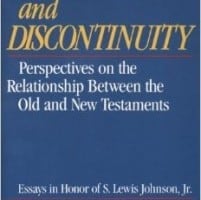⏱️ Estimated Reading Time: 5 min read
 Scripture is comprised of 66 books divided into two halves. The front of the book as it is sometimes called outlines the coming of Jesus and the back of the book discusses the impact of his life and his return with both halves revealing God’s salvation history plan. The question of how both sections of Scripture interact and relate to one another including what portions remain valid for today’s believer is an important conversation, one that if not viewed properly can seriously hamper how the understanding of Scripture in part and as a whole. The contributors to Continuity and Discontinuity: Perspectives on the Relationship Between the Old and New Testaments attempt to provide a proper overview of how to understand the flow and purpose of Scripture.
Scripture is comprised of 66 books divided into two halves. The front of the book as it is sometimes called outlines the coming of Jesus and the back of the book discusses the impact of his life and his return with both halves revealing God’s salvation history plan. The question of how both sections of Scripture interact and relate to one another including what portions remain valid for today’s believer is an important conversation, one that if not viewed properly can seriously hamper how the understanding of Scripture in part and as a whole. The contributors to Continuity and Discontinuity: Perspectives on the Relationship Between the Old and New Testaments attempt to provide a proper overview of how to understand the flow and purpose of Scripture.
Make no mistake about it, this is a heavy book with some very deep theological subject contained throughout the various essays. With that said, I appreciated what each contributor presented. John Feinberg notes in the preface the issue of how one applies continuity and discontinuity when interpreting Scripture has a massive impact on topics such as the body of Christ and the relationship between law and grace. Many theological missteps have taken place over the years due to an improper understanding of such issues.
This collection of essays is divided into seven sections: 1) Historical Perspective; 2) Theological Systems and the Testaments; 3) Hermeneutics and the Testaments; 4) Salvation and the Testaments; 5) The Law and the Testaments; 6) The People of God and the Testaments; and 7) Kingdom Promises and the Testaments. Each and every one of these topics and the perspective one takes in engaging them is vital to a proper approach to Scripture. Whether one holds to a Covenant Theological perspective, Dispensational understanding, some point in between or something completely different, at some point the individual will have to answer for example “what do I do with portions of the Law of Moses”?
I found the entirety of this book to be quite helpful and informative; however, I seemed to find myself spending a great deal of time in the section on the Law and the Testaments. This has been a subject matter of great interest to me of late as there seems to be a vast misunderstanding of what God’s Law is and to what extent the believer has been set free from “the law”. There are those who view the full nature of the Law as being nailed to the cross with the New Testament believer falling completely under the umbrella of grace with no further need for the Law. Others take a different tact, feeling that God’s Law remains in place except of course for the sacrificial system which was abrogated by the cross.
The exegesis provided by Douglas Moo on this subject was quite good in my opinion, especially his statement that the fulfillment of Matthew 5:17 “means that Jesus’ new, eschatological demands do not constitute an abandonment of the law but express that which the law was all along intended to anticipate.” Some point to Paul’s writings as an indication of freedom from the law with love being the primary driver for the New Testament believer, specifically what is termed the “law of love”. Is that really what Paul declared? Moo astutely comments “The love command, taught by Jesus himself, represents the ultimate aim and purpose of the law.” To the accusation that abandonment of the law results in antinomianism, Moo reminds the reader that is not entirely true. God’s law remains the goal and the ultimate standard of holiness for all believers. Portions of the Law of Moses, which were a shadow of something better, most notably the sacrificial system, have ceased given the cross was the perfect and final sacrifice. I do disagree that the Sabbath command has ceased, something Moo alludes to in his closing comments given that was a creation ordinance further elaborated at Mount Sinai, but other than that small comment, Moo’s comments on the statements of Jesus and the writings of Paul and how they are to be understood when it comes to the continuity and discontinuity of the law in the life of believers today were well presented and biblically sound.
This is just one of many examples I could have provided that can be found throughout this excellent book. While not an easy or quick read given the breadth and depth of material discussed, this nevertheless is a collection of essays that needs to be read. I know I will refer to many sections in this book in my continued studies on this very topic and I highly recommend this book to all believers as an important source of reference material as they further their own studies on how to best understand the grand flow of Scripture and its application to their life.
This book is available for purchase from Crossway Books by clicking here.




